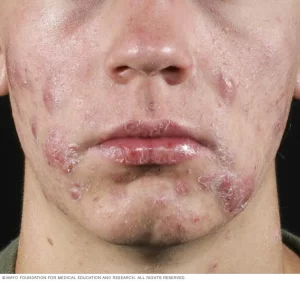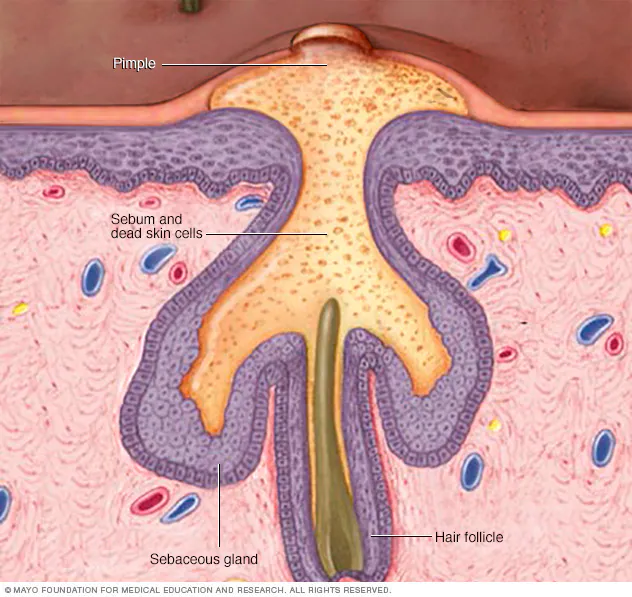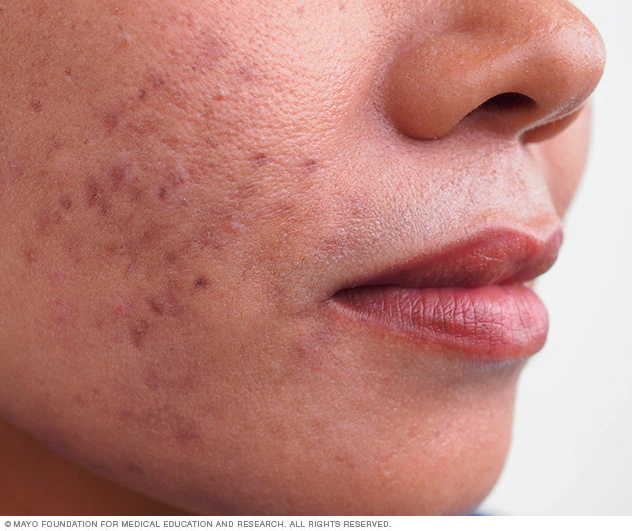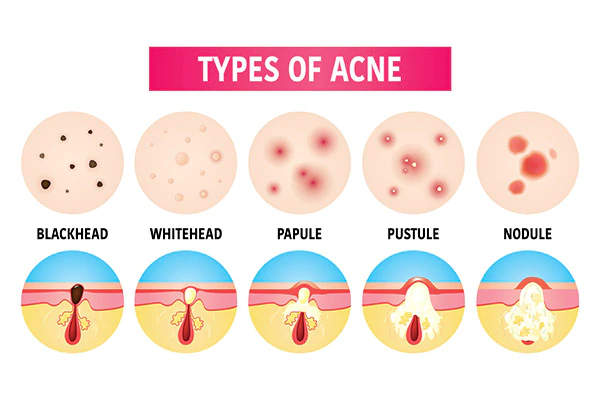What is acne?
Acne is a skin condition that occurs when your hair follicles become plugged with oil and dead skin cells. It causes whiteheads, blackheads or pimples. Acne is most common among teenagers, though it affects people of all ages.
Effective acne treatments are available, but acne can be persistent. The pimples and bumps heal slowly, and when one begins to go away, others seem to crop up.
Depending on its severity, acne can cause emotional distress and scar the skin. The earlier you start treatment, the lower your risk of such problems.
ACNE AFFECTS between 40 million and 50 million individuals in the United States.1 Although acne mainly affects adolescents, it is also present in children and adults. One study found some degree of facial acne in 54% of women and 40% of men older than 25 years.
One study found some degree of facial acne in 54% of women and 40% of men older than 25 years.
Symptoms of Acne
Acne signs vary depending on the severity of your condition:
- Whiteheads (closed plugged pores)
- Blackheads (open plugged pores)
- Small red, tender bumps (papules)
- Pimples (pustules), which are papules with pus at their tips
- Large, solid, painful lumps under the skin (nodules)
- Painful, pus-filled lumps under the skin (cystic lesions)
Acne usually appears on the face, forehead, chest, upper back and shoulders

Acne occurs when the openings of hair follicles become clogged and blocked with oil and dead skin cells. If the clogged pore becomes infected with bacteria, it forms a pimple, which is small red bump with pus at its tip.

Cystic acne — the most severe form of acne — occurs when oil and dead skin cells build up deep within hair follicles. The resulting rupture within your skin may form boil-like inflammation.
What causes acne?

Acne develops when sebum — an oily substance that lubricates your hair and skin — and dead skin cells plug hair follicles. Bacteria can trigger inflammation and infection resulting in more severe acne.
The follicle wall may bulge and produce a whitehead. Or the plug may be open to the surface and darken, causing a blackhead. A blackhead may look like dirt stuck in pores. But actually the pore is congested with bacteria and oil, which turns brown when it’s exposed to the air.
Pimples are raised red spots with a white center that develop when blocked hair follicles become inflamed or infected with bacteria. Blockages and inflammation deep inside hair follicles produce cystlike lumps beneath the surface of your skin. Other pores in your skin, which are the openings of the sweat glands, aren’t usually involved in acne.
Certain things may trigger or worsen acne:
- Androgen Hormones
Male hormones called androgens are present in males and females, and the fluctuation of these hormones create acne cycles that many people experience.Teenage boys and young men may experience greater acne development through their twenties; and because they have higher levels of androgens, males tend to suffer more severe acne than females. However, since hormones continue to fluctuate throughout women’s entire lives, women may continue to experience acne without it ever fully going away. - Certain medications. Examples include drugs containing corticosteroids, testosterone or lithium.
- Diet. Diet plays a vital role in how your skin looks, therefore foods rich in sugar and carbs can very well be one of the causes of pimples on the face. Refined carbohydrates like pasta, bread, cakes and cookies have a high glycemic index which increases the growth and severity of acne and pimples. Dairy products have an increased level of insulin response and progesterone-like hormones in them that can trigger acne breakouts. Switch to healthy snacking and munch on veggies, fruits and foods rich in protein.Studies have demonstrated that increased consumption of dietary fat or carbohydrate increases sebum production and modifications to the type of carbohydrate can also alter sebum composition.16 Typical western diet, comprised of milk and hyperglycaemic foods, may have potentiating effects on serum insulin and insulin-like growth factor-I (IGF-I) levels, thereby promoting the development of acne.17
- Stress. Stress doesn’t cause acne, but if you have acne already, stress may make it worse.
- Makeup – “Overuse of makeup, especially foundations, can lead to skin irritation or acne breakouts. Taking a break from makeup can help the skin repair itself,” says Dr. Zeichner.
There are different types of acne
What is the original purpose of sebum?
The normal function of sebaceous glands is to produce and secrete sebum, a group of complex oils including triglycerides and fatty acid breakdown products, wax esters, squalene, cholesterol esters and cholesterol. Sebum lubricates the skin to protect against friction and makes it more impervious to moisture. Furthermore, the sebaceous gland transports antioxidants in and on the skin and exhibits a natural light protective activity. It possesses an innate antibacterial activity and has a pro- and anti-inflammatory function. It can regulate the activity of xenobiotics and is actively involved in the wound healing process.5
How can you treat it?
To treat, wash your face with an acne product that contains benzoyl peroxide or salicylic acid. Resist the temptation to pop these. There is some more info on treatments here.
Can saltwater help?
There are lots of people making videos online who say that sea salt has cured or helped their acne, salt water is very cheap and has many benefits for the skin. You might notice your skin feeling refreshed after being in the sea.
As one TikToker believes, saltwater is now the key to your skin woes. Last month, @leacrylics started a routine that didn’t just solve her acne, but reduced redness and saw her pimples vanish from her complexion. The cure? Simply sea salt mixed with some water that she then sprayed on her face. Yep, you’re pretty much just dunking your head into the ocean.
She added, “I mix a teaspoon of sea salt with half a cup of warm water, make the exact same ratio as the ocean, then I just spray it on my face every night…I’m about to start my period and you can see, no breakouts.”
Other TikTok stars have been quick to adopt the trend and their reviews are equally glowing. But when you have something as simple as seawater being proclaimed as the next acne cure-all, it does raise some eyebrows. After all, wouldn’t skincare companies just be selling us salt in a bottle if it was all that effective?\
After swimming, you often notice that your skin is drier and less oily. There is some thought that not only seawater but also spa water contains different minerals which may alter the microbiome of the skin in a more acne-friendly way.
Here is how to prepare it:
Saltwater has many benefits on the skin
How is salt water good for skin when tap water is usually not? When it comes to salt water benefits, the positives of salt water far surpass anything you might feel you derive from the shower or bath. For one, tap water often contains additives that may dry out or damage your skin. Salt water benefits may do the opposite and may even provide healing properties.
Besides its “scrubby” element, sea salt acts as a great exfoliant that opens pores for a deeper clean, increase blood circulation, and allows your skin to better absorb moisturizers and other treatments.
Using salt water products can act as a salt water detox — not only for your face but the entire expanse of your skin. Salt absorbs and can draw impurities out of your skin. When used as an exfoliating agent, sea salt can help scrub away old skin cells and rejuvenate your skin tone. Salt water benefits for skin also include tightening pores and acting as a cleanser to remove oil, leaving your skin feeling fresh and bright.

